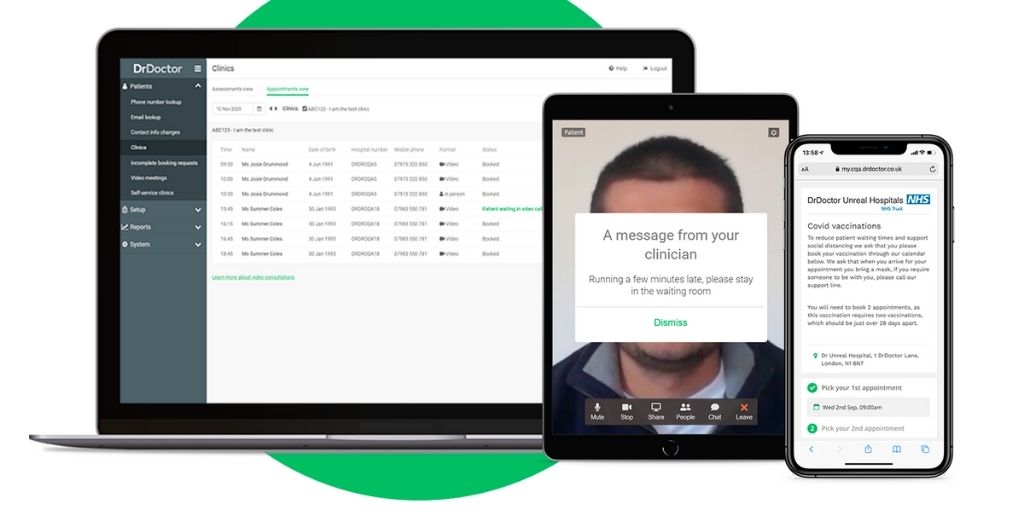
The NHS could clear the huge backlog of appointments in 8 months rather than 4 years if it used digital-first patient engagement, according to industry experts.
According to the BMA and other sources, more than 20m outpatient appointments did not take place due to Covid-19 over the 12 months to March 2021. It could take the NHS as much as four and a half years – 235 weeks – to clear this using current capacity, which is why the NHS has made it a clear focus of its latest planning guidance.
Now data from a supplier of technology widely used across the NHS shows that a quarter of outpatient appointments scheduled every week could be removed by taking a digital-first approach.
Using technology to ask patients if they need to be seen, and to check whether a patient’s symptoms are getting worse remotely, could release much-needed clinical and administrative capacity. This extra headroom could help the NHS clear the appointments backlog in 35 weeks, just 8 months.
Digital patient engagement specialist DrDoctor supports over 30 NHS organisations with services including appointments management, patient engagement and virtual consultation. It has seen NHS organisations increase clinical capacity by using its patient-centred software suite to help release staff to address the waiting list challenge.
“DrDoctor is showing how the NHS is embracing a digital-first approach to provide staff with the support and breathing space they need to clear the appointments backlog,” said DrDoctor CEO Tom Whicher. “If this was done across the NHS, it would release additional capacity – of 516,805 appointments per week.”
National data suggests that 2.4m outpatient appointments are scheduled to take place each week. Of those, around 1.8m usually take place, after removing those that would have been cancelled or where patients did not attend.
Once these have taken place, DrDoctor estimates that staff – already exhausted after months of dealing with Covid – might have an extra 5% headroom to clear the backlog.
Such a productivity increase would be far and above average growth rates for healthcare. The extra effort would also have to be found from every single doctor and nurse and booking clerk.
Even with this extra effort, DrDoctor suggests that the NHS only has capacity for an extra 85,062 appointments per week. With up to 20m appointments that need to be processed, this means it could take up to 235 weeks – four and a half years – to clear the backlog.
However, DrDoctor’s experience with leading healthcare providers shows that technology-driven approaches could release the capacity for staff to cut the backlog in a matter of weeks, and without the additional burden on staff.
One such example is waiting list validation, which sees the NHS send digital letters, texts and emails to check that people still need or want to be seen.
DrDoctor customers have used this approach to help cut the waiting list by 3% to 27% in some cases. Taking an average of 10% across all specialities, using digitally-driven waiting list validation means the NHS could clear the backlog in 212 weeks.
Checking that patients need a follow up appointment using digital means has an even bigger impact. This is usually done manually by nurses or booking clerks calling patients during office hours.
Taking a digital-first approach can massively extend this activity without putting an additional burden on staff. This would help provide the NHS the capacity it needs to slash appointments.
For certain conditions and treatments, such as immunotherapy, ‘patient initiated follow ups’ (PIFU) are only needed when an individual’s symptoms require this. That’s not always the case, and often it is down to nurses or booking clerks to check with the patient if they need such an appointment.
With digital patient engagement and remote monitoring technology, patients can let their doctors know continuously if their symptoms get worse and if they need or want to be seen. Doctors too can keep a closer eye on patients who might be at risk, without the need for an in-person appointment.
As a result, the NHS could release an extra 24% of capacity, which could be used to further help reduce the appointment waiting list. This could release an extra 431,743 appointments per week.
Together with waiting list validation, this digital-first approach means the NHS could clear the backlog in 35 weeks – just eight months, rather than the four-plus years it could take.
Whicher continued: “Throughout the pandemic, seeing and engaging patients using a digital first approach has been a major part of the NHS response. We believe that this needs to be enhanced and embedded as business as usual to clear the backlog.
“Digital patient engagement helps release capacity to support those who use existing channels. It can also lay a foundation for more personalized care, that will help the NHS tailor care in ways that address health inequalities. It is the platform for a more productive and sustainable NHS.”












